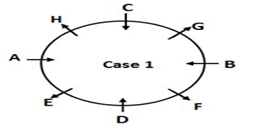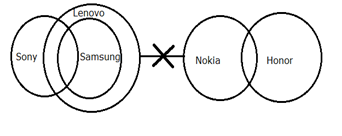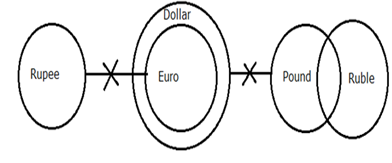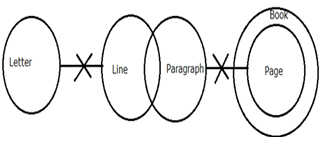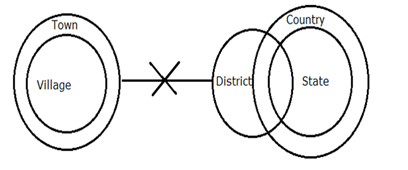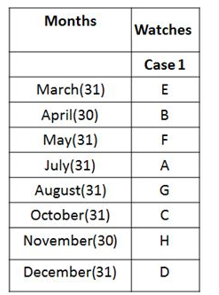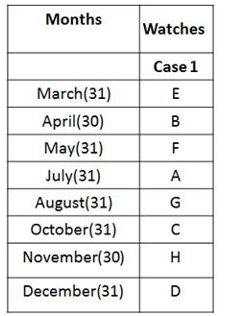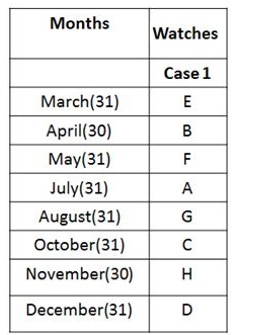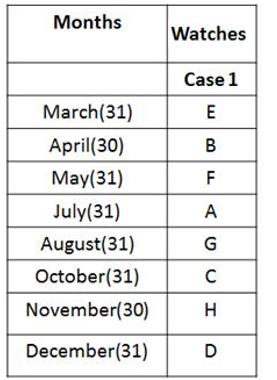Question 1:
निर्देश : निम्नलिखित जानकारी का ध्यानपूर्वक अध्ययन करें और नीचे दिए गए प्रश्नों का उत्तर दें।
Direction : Study the following information carefully and answer the questions given below.
आठ व्यक्ति A, B, C, D, E, F, G और H एक वृत्ताकार टेबल के गिर्द बैठे हैं लेकिन जरूरी नहीं उसी क्रम में। उनमें से चार केंद्र की ओर मुख किए हैं और शेष केंद्र के विपरीत ओर मुख किए हैं।
Eight persons A, B, C, D, E, F, G and H are sitting around a circular table but not necessarily in the same order. Four of them are facing towards the center and remaining is facing opposite to the center.
B, D के दाईं ओर दूसरे स्थान पर बैठता है। F, C के बाईं ओर तीसरे स्थान पर बैठता है। E, G के विपरीत बैठता है जो C और B का निकटतम पड़ोसी है। A, F और H के विपरीत नहीं बैठता है। F, केंद्र के बाहर की ओर मुख करता है और A के दाईं ओर तीसरे स्थान पर बैठता है। A और F विपरीत दिशा की ओर मुख करते हैं। A का निकटतम पड़ोसी उसी दिशा की ओर मुख करते हैं जिस दिशा में A के विपरित व्यक्ति करता है। B और C एक ही दिशा की ओर मुख करते हैं।
B sits second to the right of D. F sits third to the left of C. E sits opposite to G who is an immediate neighbor of C and B. A doesn’t sits opposite to F and H. F faces outside the center and sits third to the right of A. A and F are facing opposite direction. Immediate neighbor of A are facing same direction which is opposite to A. B and C are facing same direction.
Four of the following five in such a way to form a group, which one of the following does not belong to the group?
निम्नलिखित पांच में से चार एक निश्चित प्रकार से समूह बनाते है, निम्नलिखित में से कौन सा समूह से संबंधित नहीं है?
Question 2:
निर्देश : नीचे दिए गए प्रश्नों में एक कथन दिया गया है जिसके बाद दो और निष्कर्ष क्रमांकित I और II हैं। आपको कथन में सबकुछ सत्य मानना है, फिर दोनों निष्कर्षों पर एक साथ विचार करें और निर्णय लें कि उनमें से कौन सा तार्किक रूप से कथन में दी गई जानकारी का अनुसरण करता है। उत्तर दें:
Direction : In the questions below a statement is given followed by two conclusions numbered I and II. You have to assume everything in the statement to be true, then consider the two conclusions together and decide which of them logically follows from the information given in the statement. Give Answer:
(a) If either conclusion I or conclusion II follows यदि या तो निष्कर्ष I या निष्कर्ष II अनुसरण करता है
(b) If only conclusion I follow यदि केवल निष्कर्ष I अनुसरण करता है
(c) If both conclusion I and conclusion II follows यदि दोनों निष्कर्ष I और निष्कर्ष II अनुसरण करता है
(d) If only conclusion II follows यदि केवल निष्कर्ष II अनुसरण करता है
(e) If neither conclusion I nor conclusion II follows यदि न तो निष्कर्ष I न निष्कर्ष II अनुसरण करता है
Statements: Some Sony are Samsung, All Samsung are Lenovo
कथन: कुछ सोनी सैमसंग हैं,सभी सैमसंग लेनोवो हैं
No Lenovo is Nokia, Some Nokia are Honor
कोई लेनोवो नोकिया नहीं है, कुछ नोकिया ऑनर हैं
निष्कर्ष: Conclusions:
I. कुछ सोनी नोकिया नहीं हैं
I. Some Sony are not Nokia
II. कुछ लेनोवो ऑनर नहीं हैं
II. Some Lenovo not Honor
Question 3:
निर्देश : नीचे दिए गए प्रश्नों में एक कथन दिया गया है जिसके बाद दो और निष्कर्ष क्रमांकित I और II हैं। आपको कथन में सबकुछ सत्य मानना है, फिर दोनों निष्कर्षों पर एक साथ विचार करें और निर्णय लें कि उनमें से कौन सा तार्किक रूप से कथन में दी गई जानकारी का अनुसरण करता है। उत्तर दें:
Direction : In the questions below a statement is given followed by two conclusions numbered I and II. You have to assume everything in the statement to be true, then consider the two conclusions together and decide which of them logically follows from the information given in the statement. Give Answer:
(a) If either conclusion I or conclusion II follows यदि या तो निष्कर्ष I या निष्कर्ष II अनुसरण करता है
(b) If only conclusion I follow यदि केवल निष्कर्ष I अनुसरण करता है
(c) If both conclusion I and conclusion II follows यदि दोनों निष्कर्ष I और निष्कर्ष II अनुसरण करता है
(d) If only conclusion II follows यदि केवल निष्कर्ष II अनुसरण करता है
(e) If neither conclusion I nor conclusion II follows यदि न तो निष्कर्ष I न निष्कर्ष II अनुसरण करता है
Statements: Some F1 are F2. Some F2 are F3.
कथन: कुछ F1, F2 है, कुछ F2, F3 है
No F3 is F4. All F4 are F5.
निष्कर्ष: I. कुछ F3, F5 नहीं है
Conclusions: I. Some F3 are not F5.
II. All F3 are F1 is a possibility सभी F3 के F1 होने की संभावना है
Question 4:
निर्देश : नीचे दिए गए प्रश्नों में एक कथन दिया गया है जिसके बाद दो और निष्कर्ष क्रमांकित I और II हैं। आपको कथन में सबकुछ सत्य मानना है, फिर दोनों निष्कर्षों पर एक साथ विचार करें और निर्णय लें कि उनमें से कौन सा तार्किक रूप से कथन में दी गई जानकारी का अनुसरण करता है। उत्तर दें:
Direction : In the questions below a statement is given followed by two conclusions numbered I and II. You have to assume everything in the statement to be true, then consider the two conclusions together and decide which of them logically follows from the information given in the statement. Give Answer:
(a) If either conclusion I or conclusion II follows यदि या तो निष्कर्ष I या निष्कर्ष II अनुसरण करता है
(b) If only conclusion I follow यदि केवल निष्कर्ष I अनुसरण करता है
(c) If both conclusion I and conclusion II follows यदि दोनों निष्कर्ष I और निष्कर्ष II अनुसरण करता है
(d) If only conclusion II follows यदि केवल निष्कर्ष II अनुसरण करता है
(e) If neither conclusion I nor conclusion II follows यदि न तो निष्कर्ष I न निष्कर्ष II अनुसरण करता है
Statements: No Rupee is Euro.All Euros are Dollar.
कथन: कोई रुपया यूरो नहीं है,सभी यूरो डॉलर हैं
कोई डॉलर पाउंड नहीं है,कुछ पाउंड रूबल हैं
No Dollar is pound.Some Pound are Ruble.
निष्कर्ष: I. कोई डॉलर रूबल नहीं है
Conclusions: I. No Dollar is Ruble
II. No Pound is Rupee कोई पाउंड रुपया नहीं है
Question 5:
निर्देश : नीचे दिए गए प्रश्नों में एक कथन दिया गया है जिसके बाद दो और निष्कर्ष क्रमांकित I और II हैं। आपको कथन में सबकुछ सत्य मानना है, फिर दोनों निष्कर्षों पर एक साथ विचार करें और निर्णय लें कि उनमें से कौन सा तार्किक रूप से कथन में दी गई जानकारी का अनुसरण करता है। उत्तर दें:
Direction : In the questions below a statement is given followed by two conclusions numbered I and II. You have to assume everything in the statement to be true, then consider the two conclusions together and decide which of them logically follows from the information given in the statement. Give Answer:
(a) If either conclusion I or conclusion II follows यदि या तो निष्कर्ष I या निष्कर्ष II अनुसरण करता है
(b) If only conclusion I follow यदि केवल निष्कर्ष I अनुसरण करता है
(c) If both conclusion I and conclusion II follows यदि दोनों निष्कर्ष I और निष्कर्ष II अनुसरण करता है
(d) If only conclusion II follows यदि केवल निष्कर्ष II अनुसरण करता है
(e) If neither conclusion I nor conclusion II follows यदि न तो निष्कर्ष I न निष्कर्ष II अनुसरण करता है
Statements: No Letter is Line. Some Line is Paragraph
कथन: कोई लेटर लाइन नहीं है, कुछ लाइन पैराग्राफ है
कोई पैराग्राफ पेज नहीं है, सभी पेज बुक हैं No Paragraph is a Page. All Page are Book
निष्कर्ष: I. कुछ लेटर बुक हैं Conclusions: I. Some Letter are Book
II. Some Line being Page is a Possibility कुछ लाइन के पेज होने की संभावना है
Question 6:
निर्देश : नीचे दिए गए प्रश्नों में एक कथन दिया गया है जिसके बाद दो और निष्कर्ष क्रमांकित I और II हैं। आपको कथन में सबकुछ सत्य मानना है, फिर दोनों निष्कर्षों पर एक साथ विचार करें और निर्णय लें कि उनमें से कौन सा तार्किक रूप से कथन में दी गई जानकारी का अनुसरण करता है। उत्तर दें:
Direction : In the questions below a statement is given followed by two conclusions numbered I and II. You have to assume everything in the statement to be true, then consider the two conclusions together and decide which of them logically follows from the information given in the statement. Give Answer:
(a) If either conclusion I or conclusion II follows यदि या तो निष्कर्ष I या निष्कर्ष II अनुसरण करता है
(b) If only conclusion I follow यदि केवल निष्कर्ष I अनुसरण करता है
(c) If both conclusion I and conclusion II follows यदि दोनों निष्कर्ष I और निष्कर्ष II अनुसरण करता है
(d) If only conclusion II follows यदि केवल निष्कर्ष II अनुसरण करता है
(e) If neither conclusion I nor conclusion II follows यदि न तो निष्कर्ष I न निष्कर्ष II अनुसरण करता है
Statements: All Village are Town. No town is a District
कथन: सभी गांव शहर हैं, कोई शहर जिला नहीं है
कुछ जिला राज्य है, सभी राज्य देश है
Some District is State. All State is country
निष्कर्ष: I. कोई जिला गांव नहीं है कुछ देश जिला है
Conclusions: I. No District is a Village
II. Some Country is District
II.कुछ देश जिला है
Question 7:
निर्देश : निम्नलिखित जानकारी का ध्यानपूर्वक अध्ययन करें और नीचे दिए गए प्रश्नों का उत्तर दें।
Direction : Study the following information carefully and answer the questions given below.
आठ घड़ियों A, B, C, D,E, F, G और H को उसी वर्ष के आठ अलग-अलग महीनों मार्च, अप्रैल, मई, जुलाई, अगस्त, अक्टूबर, नवंबर और दिसंबर में खरीदा गया था, लेकिन जरूरी नहीं उसी क्रम में।
Eight watches A, B, C, D,E, F, G and H were bought on eight different months March, April, May, July, August, October, November and December of the same year but not necessarily in the same order.
घड़ी E, मार्च को खरीदा गया था। घड़ी H को उस महीने खरीदा गया था जिसमें 30 दिन हैं। H और A के बीच दो घड़ी खरीदे गए थे। घड़ी G को घड़ी C से पहले खरीदा गया था। D और F, जो G से पहले खरीदा गया था, के बीच चार घड़ियों को खरीदा गया था। B और G के बीच खरीदी गई घड़ी, F और C के बीच खरीदी गई घड़ी के समान हैं।
The watch E was bought on March. The watch H was bought on the month which has 30 days. Two watches were bought between H and A. The watch G was bought just before C. Four watches were bought between D and F which was bought before G. As many watches bought between B and G is as same as between F and C.
Watch C was bought on which of the following months?
घड़ी C निम्नलिखित किस महिने में खरीदा गया था?
Question 8:
निर्देश : निम्नलिखित जानकारी का ध्यानपूर्वक अध्ययन करें और नीचे दिए गए प्रश्नों का उत्तर दें।
Direction : Study the following information carefully and answer the questions given below.
आठ घड़ियों A, B, C, D,E, F, G और H को उसी वर्ष के आठ अलग-अलग महीनों मार्च, अप्रैल, मई, जुलाई, अगस्त, अक्टूबर, नवंबर और दिसंबर में खरीदा गया था, लेकिन जरूरी नहीं उसी क्रम में।
Eight watches A, B, C, D,E, F, G and H were bought on eight different months March, April, May, July, August, October, November and December of the same year but not necessarily in the same order.
घड़ी E, मार्च को खरीदा गया था। घड़ी H को उस महीने खरीदा गया था जिसमें 30 दिन हैं। H और A के बीच दो घड़ी खरीदे गए थे। घड़ी G को घड़ी C से पहले खरीदा गया था। D और F, जो G से पहले खरीदा गया था, के बीच चार घड़ियों को खरीदा गया था। B और G के बीच खरीदी गई घड़ी, F और C के बीच खरीदी गई घड़ी के समान हैं।
The watch E was bought on March. The watch H was bought on the month which has 30 days. Two watches were bought between H and A. The watch G was bought just before C. Four watches were bought between D and F which was bought before G. As many watches bought between B and G is as same as between F and C.
How many watches were bought between H and G?
H और G के बीच कितने घड़ी खरीदे गए थे?
Question 9:
निर्देश : निम्नलिखित जानकारी का ध्यानपूर्वक अध्ययन करें और नीचे दिए गए प्रश्नों का उत्तर दें।
Direction : Study the following information carefully and answer the questions given below.
आठ घड़ियों A, B, C, D,E, F, G और H को उसी वर्ष के आठ अलग-अलग महीनों मार्च, अप्रैल, मई, जुलाई, अगस्त, अक्टूबर, नवंबर और दिसंबर में खरीदा गया था, लेकिन जरूरी नहीं उसी क्रम में।
Eight watches A, B, C, D,E, F, G and H were bought on eight different months March, April, May, July, August, October, November and December of the same year but not necessarily in the same order.
घड़ी E, मार्च को खरीदा गया था। घड़ी H को उस महीने खरीदा गया था जिसमें 30 दिन हैं। H और A के बीच दो घड़ी खरीदे गए थे। घड़ी G को घड़ी C से पहले खरीदा गया था। D और F, जो G से पहले खरीदा गया था, के बीच चार घड़ियों को खरीदा गया था। B और G के बीच खरीदी गई घड़ी, F और C के बीच खरीदी गई घड़ी के समान हैं।
The watch E was bought on March. The watch H was bought on the month which has 30 days. Two watches were bought between H and A. The watch G was bought just before C. Four watches were bought between D and F which was bought before G. As many watches bought between B and G is as same as between F and C.
Which of the following watch was bought just before the watch which was bought on July?
जुलाई में खरीदी गई घड़ी से पहले निम्नलिखित में से कौन सी घड़ी खरीदी गई थी?
Question 10:
निर्देश : निम्नलिखित जानकारी का ध्यानपूर्वक अध्ययन करें और नीचे दिए गए प्रश्नों का उत्तर दें।
Direction : Study the following information carefully and answer the questions given below.
आठ घड़ियों A, B, C, D,E, F, G और H को उसी वर्ष के आठ अलग-अलग महीनों मार्च, अप्रैल, मई, जुलाई, अगस्त, अक्टूबर, नवंबर और दिसंबर में खरीदा गया था, लेकिन जरूरी नहीं उसी क्रम में।
Eight watches A, B, C, D,E, F, G and H were bought on eight different months March, April, May, July, August, October, November and December of the same year but not necessarily in the same order.
घड़ी E, मार्च को खरीदा गया था। घड़ी H को उस महीने खरीदा गया था जिसमें 30 दिन हैं। H और A के बीच दो घड़ी खरीदे गए थे। घड़ी G को घड़ी C से पहले खरीदा गया था। D और F, जो G से पहले खरीदा गया था, के बीच चार घड़ियों को खरीदा गया था। B और G के बीच खरीदी गई घड़ी, F और C के बीच खरीदी गई घड़ी के समान हैं।
The watch E was bought on March. The watch H was bought on the month which has 30 days. Two watches were bought between H and A. The watch G was bought just before C. Four watches were bought between D and F which was bought before G. As many watches bought between B and G is as same as between F and C.
Which of the following watch was bought on August?
अगस्त में निम्नलिखित में से कौन सी घड़ी खरीदी गई थी?

